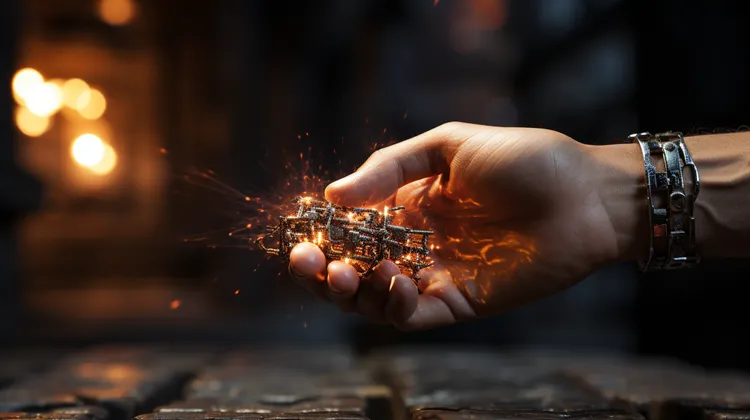The latest trend making waves in the cryptocurrency market is the tokenization of real-world assets (RWA), driven largely by the interest of significant financial institutions such as BlackRock. RWA tokenization involves converting ownership rights of financial or physical assets into digital tokens. These tokens offer an immutable and transferable record of ownership, which can then be issued, bought, sold, and traded across various exchanges and platforms. Thanks to blockchain technology, traditionally illiquid assets like real estate and U.S. Treasurys can now be traded on decentralized finance (DeFi) protocols. The market for RWA tokens currently stands at around $7 billion, with expectations to grow dramatically to $16 trillion by 2030.
The idea of tokenizing real-world assets is not new; it has been around since the early days of cryptocurrency. One of the first practical applications of RWA tokenization was stablecoins, where one token represents a single unit of fiat currency such as the U.S. dollar. Over time, the scope of tokenization has expanded to include a wider array of assets, including bonds, stocks, fixed income instruments, and real estate. The sector garnered mainstream attention when BlackRock, the world’s largest asset manager, introduced its BUIDL asset tokenization platform, making RWAs a notable element of the DeFi industry by 2023.
A Bitfinex analyst highlighted that broader economic conditions and the integration of cryptocurrencies with traditional financial markets will significantly influence the future of RWAs in DeFi. As financial markets increasingly view cryptocurrencies as a legitimate asset class, there will be more opportunities for RWAs to bring stability and real-world grounding to DeFi projects. Such stability is particularly crucial in the current volatile economic environment, potentially enhancing the attractiveness and reliability of DeFi platforms.
Historically, DeFi has focused primarily on assets native to the cryptocurrency world. Incorporating RWAs represents a major shift. This transition allows the DeFi sector to access a broader variety of assets, such as bonds, real estate, commodities, and intellectual property. RWAs are currently the fastest-growing asset class within DeFi. While DeFi has revolutionized finance with services like lending and yield products, it remains known for its volatility. Issues like depegging stablecoins, liquidity shortages, and liquidations of leveraged positions are common. By contrast, incorporating RWAs helps to reduce DeFi’s reliance on the volatile cryptocurrency market through diversification.
Graeme Moore, head of tokenization at the Polymesh Association, pointed out that RWAs offer stable and consistent outcomes by diversifying assets, thereby reducing risk. Moore explained that RWAs are well-suited to blockchain technology. By allowing the custody and utilization of RWAs without needing a central intermediary, blockchain aims to revolutionize capital markets globally, much like how the internet transformed global communications.
In recent years, prominent DeFi protocols have started incorporating RWAs for various purposes, including yield products, algorithmic stablecoin backing, and liquidity needs. For instance, MakerDAO was a pioneer in using RWAs as collateral for its decentralized stablecoin, Dai. The protocol integrated RWAs following a vote by MKR token holders in November 2020. Today, RWAs back approximately 46% of the Dai in circulation and contribute around 48% of MakerDAO’s projected annual revenue.
Kevin de Patoul, CEO of DeFi market maker Keyrock, believes RWAs in DeFi products are still in their early stages. He notes a growing trend towards tokenizing real-world assets, from Treasury bills to corporate bonds, as the blockchain industry matures. Highlighting PV01, a debt tokenizing firm, de Patoul noted that bringing U.S. Treasury bills onto the Ethereum blockchain illustrates that even traditionally “boring” asset classes can benefit from tokenization. This has undoubtedly improved the risk profile of PV01’s collateral assets and has generated more than $100 million in annualized revenue.
Sam MacPherson, co-founder and CEO of Phoenix Labs, which contributes to MakerDAO’s Spark lending protocol, emphasizes that the growth in RWA adoption and revenue signifies the merging of the DeFi and traditional finance (TradFi) worlds. As more institutional actors realize the benefits of on-chain assets, including real-time settlement, traditional investors will increasingly explore other DeFi products like lending and stablecoins. MacPherson predicts that the advantages of tokenization will eventually compel all conventional finance to become tokenized.
Protocols such as Frax Finance are utilizing RWAs to enhance the stability of their stablecoins and develop unique DeFi yield products. Frax Finance uses an oracle that tracks the interest on U.S. Federal Reserve balances, widely accepted as the “risk-free rate” of the U.S. dollar. Similarly, Mountain Protocol leverages RWAs for its yield-bearing stablecoin, USDM, backed by short-term U.S. Treasurys. Aave DAO also employs RWAs to generate revenue from otherwise idle crypto-native assets under its management, exploring off-chain yields through RWA investments.
As more diverse real-world assets enter DeFi protocols, the ecosystem stands on the brink of a wave of innovative financial instruments and services. With an increasingly diverse array of assets, protocols can create new products that cater to various investor preferences while ensuring a level of market stability and reliability comparable to traditional finance.




By the time regulators catch up with RWAs, who knows what new rules will come into play? It’s a risky gamble. 🎲⚡
Huge props to all the protocols adopting RWAs! The DeFi space will never be the same.
Tokenizing real-world assets is the perfect mix of tradition and innovation! Loving how this can bring stability to the volatile crypto market.
So exciting to see how tokenizing Treasury bills and bonds can stabilize DeFi platforms! This is what the financial world needs.
Tokenizing real-world assets sounds great on paper, but the execution is always the issue! Blockchain isn’t the solution to every problem, especially with such volatile assets.
Wow, $16 trillion by 2030? Tokenization of RWAs is definitely here to stay! 🌐💸 Let’s keep an eye on this!
Tokenizing assets like real estate on the blockchain is groundbreaking! It makes investments more accessible and transparent.
RWAs might be the new hype, but let’s not forget the numerous scams and regulatory problems that could arise. Buyer beware!
The economic impact of integrating RWAs is enormous. Can’t wait to see how this shapes the future of finance! 📊🌍💎
This is a game-changer for the crypto world! The tokenization of real-world assets is the next big step in making DeFi more stable and accessible.
Tokenizing real-world assets may seem innovative, but the integration issues could be enormous. DeFi should focus on fixing its core problems first.
MakerDAO is ahead of the curve with RWAs backing its stablecoin. This is how you bring real-world stability to the digital world.
This trend is absolutely fascinating. BlackRock’s involvement only adds credibility to the future of RWA tokenization in DeFi.
Tokenizing assets is like bringing the best of both worlds together. Real-world stability meets DeFi potential!
Innovation at its finest! Tokenizing assets like US Treasurys will add a whole new layer of security to DeFi.